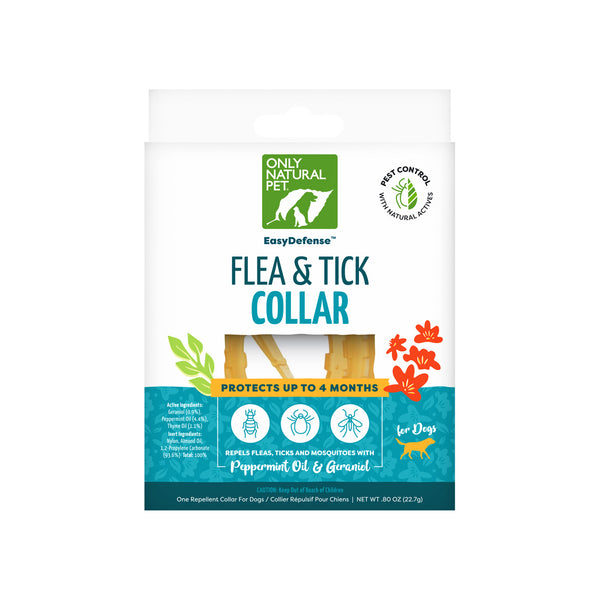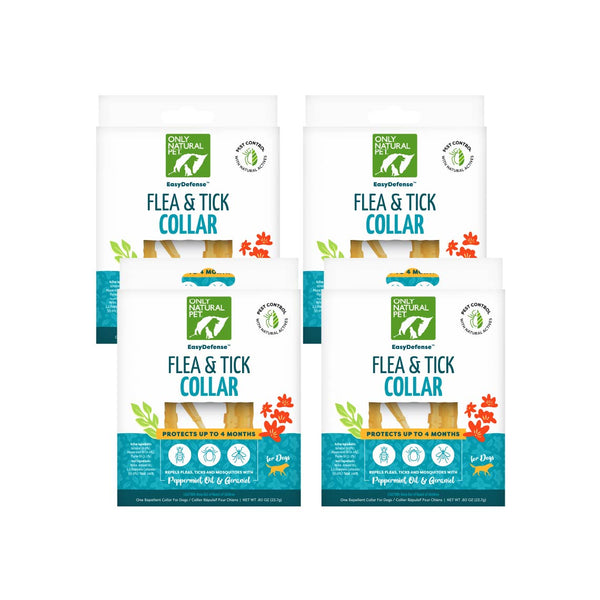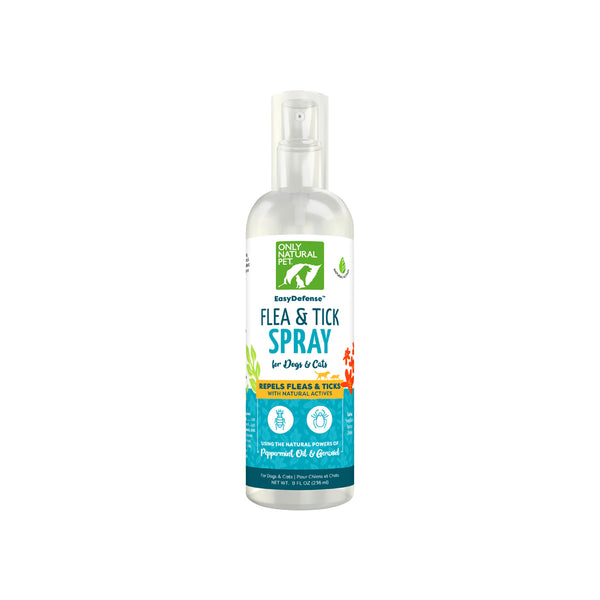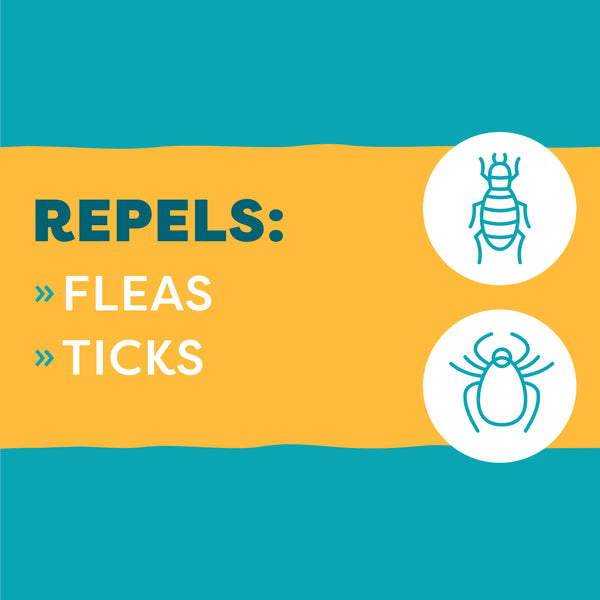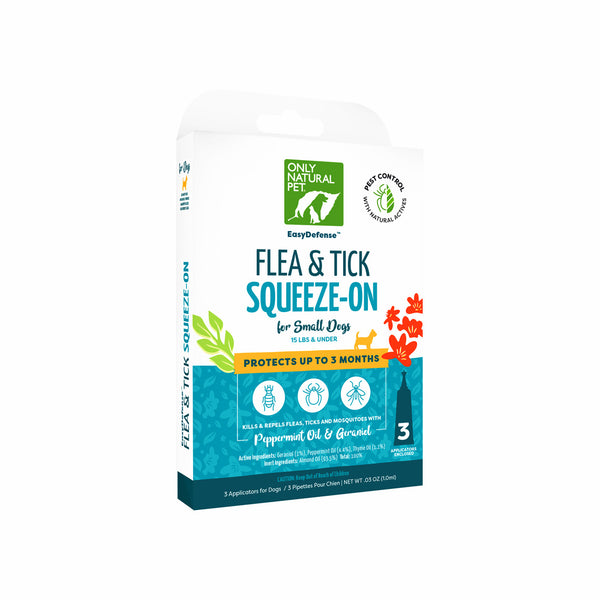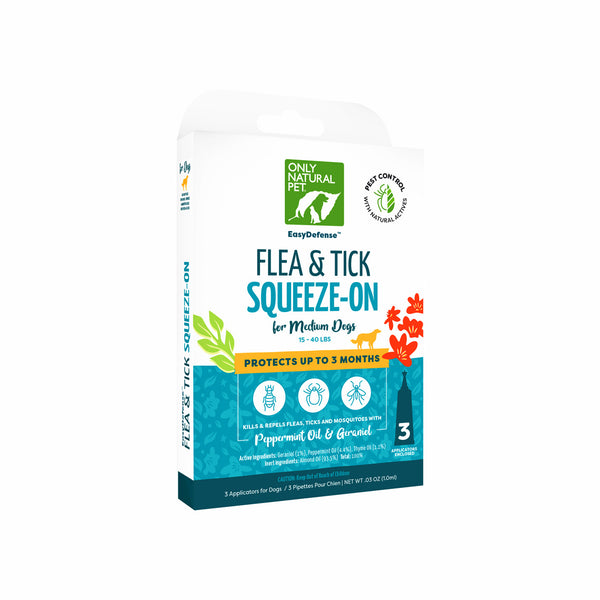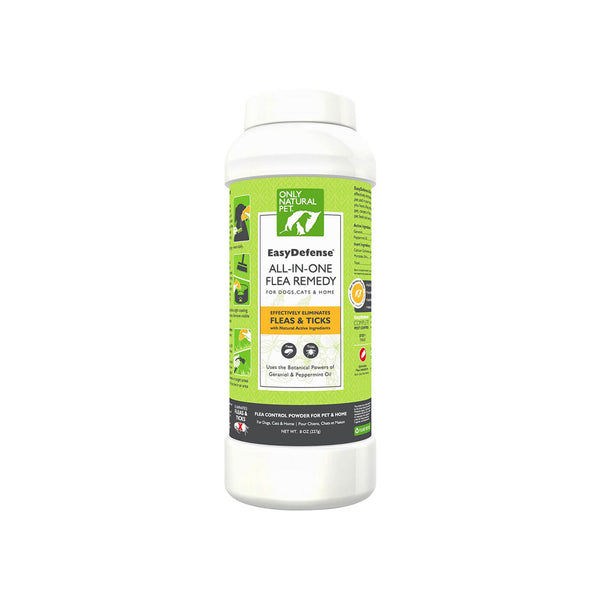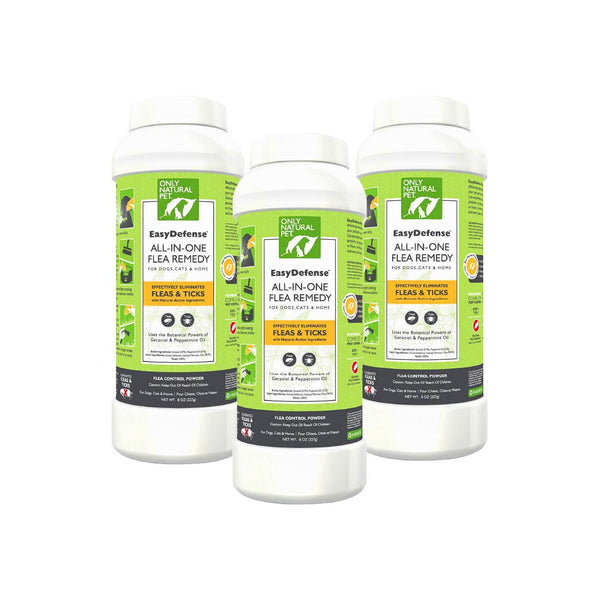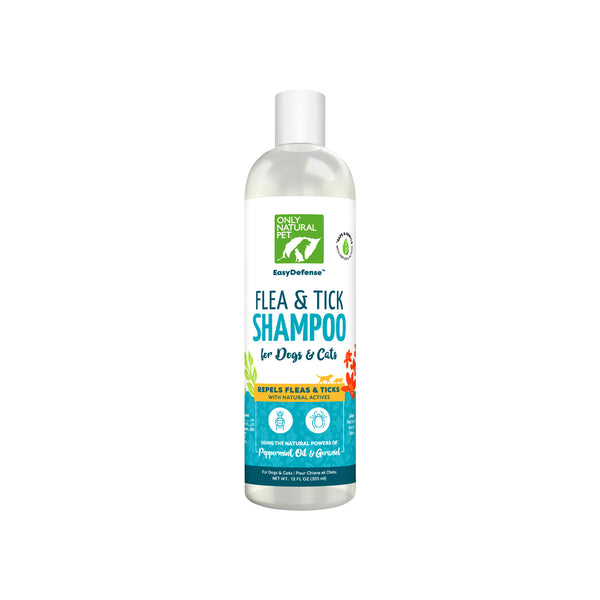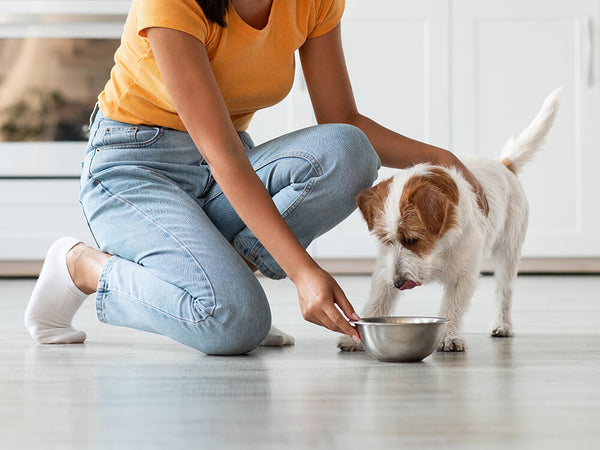Natural Flea Control Treatment & Repellent Methods for Dogs & Cats
Written by: Dr. Jean Hofve, Holistic Veterinarian, DVM
What Are the Best Natural Flea Killers, Treatments & Repellents for Pets?
Fleas! Everyone hates these blood-sucking parasites. Our war against fleas is epic and ongoing, but each of us must fight our own individual battles. At Only Natural Pet, we want to give you the best weapons: only what works, and only what is safe for you, your pets, and the environment.
"There are three fronts in every battle against fleas: the pet(s), the home, and the outdoor environment. But before we sound the battle cry, we need to know our enemy. "
Why Are Fleas Such a Fierce Enemy?
"Fleas come with three basic marching orders, or biological imperatives: to survive, to eat, and to reproduce."
Fleas have a number of strategic advantages in this war:
-
Masters of Maneuvers – Fleas are tiny, hard-shelled insects with incredible muscle power in their hind legs; they can jump 4-5 feet horizontally (or nearly a foot straight up). They're fast. They're adaptable. And they're hard to kill.
-
Storm Trooper Mentality – Fleas come with three basic marching orders, or biological imperatives: to survive, to eat, and to reproduce. They are entirely devoted to these orders. And they are very, very good at all of them. They are especially good at reproducing; an adult female lays about 20 eggs at a time. In her lifetime (depending on conditions, up to 1-1/2 years), she may produce hundreds, even thousands of eggs.
-
Effective Recruitment - The female flea typically lays her tiny white eggs in dark, damp places. If she lays any eggs on your pet, they will fall off, but they could travel all around the house or yard first. Within their hiding places, the eggs will hatch in about a week (although they can delay hatching until conditions are ideal) into larvae. The larvae then pupate by spinning cocoons, in which they can finish their development in a week. However, they can survive in their cocoons for up to 6 months.
-
Subterfuge Specialists – For every single adult flea you see, there are about 10 cocoons, 35 larvae and 50 eggs hiding in carpets, pet beds, cracks, corners, and furniture.
-
Weapons of Mass Annoyance – Flea bites are itchy because, when fleas bite to feed, they inject blood thinning compounds to prevent clotting during dinner. Not only do these anti-clotting proteins cause itching, but they can also cause the immune system to mount an allergic reaction. Flea-allergic dermatitis is one of the most common skin complaints in pets. For an allergic animal, just one flea bite can cause a massive and prolonged reaction. Fleas can also transmit diseases such as bubonic plague, typhus, Lyme disease, and Rocky Mountain spotted fever, as well as tapeworms.
-
Efficient Defenses – Most chemicals, including bombs and sprays, kill only adult fleas or adults and larvae. That leaves thousands of tough little eggs and cocoons just waiting for the proper conditions, when they'll renew their assault once more. Fleas are also well defended against famine conditions – one blood meal can keep an adult flea alive for up to two months.
The Best Natural Defensive Strategies (Including Natural Flea Killers) for Pets
Inner Defenses Against Fleas
Like other parasites, fleas target less healthy hosts, as well as puppies and kittens with undeveloped immune systems. Therefore, the first defense for our pets is to optimize their health and immunity.
If you've read any of the other articles on our site, you've heard this before: Diet is the foundation of health. After years of experience and research, we have come to believe that the best diet for most dogs and cats is a biologically appropriate raw food ("BARF") diet. Not everyone is comfortable with or can manage to feed a raw diet, but it is important to feed the very best diet you can. This means top quality commercial pet foods that contain no by-products, unnamed meat meals or bone meals, chemical preservatives, or other artificial additives. Meat should be the primary protein. Dogs can be fed a mix of canned and dry foods, but cats need moisture in their diets. They should be fed mostly or only canned foods, or reconstituted dehydrated or freeze-dried foods. Avoid carbohydrates, especially corn and wheat, as much as possible for cats. For more information, see our article, What You Need to Know About Your Pet's Food.
Garlic and B-vitamins seem to make blood less attractive to fleas, so many guardians supplement with garlic and brewer's yeast during flea season. Sensitive animals can develop an allergy to brewer's yeast, so monitor your pet to guard against worsening itchiness (pruritus).
"The first defense for our pets is to optimize their health and immunity. Experience and research shows that the best diet for most dogs and cats is a biologically appropriate raw food ("BARF") diet."
Outer Defenses Against Fleas
The ultimate weapon in the battle against fleas is the Flea Comb. It is the best method to discover whether fleas are present. Comb through your pet's fur and gather a bit of hair and dirt. Next, put this between two damp white paper towels and press them together – if the "dirt" creates rusty reddish spots on the paper towel, then a flea has been there (the dirt is actually flea feces). If you keep combing (especially around the tummy and tail), you will likely trap some of them in the comb. Drown them in soapy water – fleas have been known to jump out of plain water. Daily flea combing may sound tedious, but it is very helpful while you are working on your companion's health and taking environmental action.
Many topical sprays and shampoos claim to repel or kill fleas. However, many of them contain chemicals and pesticides with serious toxic potential. Cats are particularly susceptible to such products, because they are constantly grooming themselves and ingesting whatever is on their fur. Even sprays or chemicals from the dog can transfer to furniture or rugs, and from there to the cat. So, be extremely cautious with chemicals.
"Many topical sprays and shampoos claim to repel or kill fleas. However, many of them contain chemicals and pesticides with serious toxic potential."
Safe Flea Repellents for Dogs
We recommend essential oil-based, non-chemical products to help keep fleas away from your dog. Products which contain essential oils not only help repel fleas, they can also help soothe and heal irritated skin. You can use them as a drop you put on the collar or dilute it into a spray to mist your dog. Combining a little essential oil repellent spray with your flea combing is a great way to both spread the essential oils throughout the coat and give you extra help with catching the fleas. Pay particular attention to the base of the tail, and under the legs and belly on dogs. When using any strong smelling product, keep in mind that your dog or cat has a much stronger sense of smell than you do, so don't overdo it.
Geraniol is an extremely effective flea repellent derived from geranium flowers. Geraniums have long been planted around homes and in window boxes to keep pests like fleas and mosquitoes away. Going forward with this idea, scientists were able to extract geraniol, an oil that is 400% more effective than citronella at repelling fleas, ticks and mosquitoes.
Safe Flea Repellent for Cats
Neem products are also good for cats; comb in especially around the neck, chest, and belly. Follow all directions carefully for best results. Never use full-strength essential oils directly on cats (spray products are already diluted to safe levels). Geraniol is one of the few oils that's safe for use with cats. Geraniol's repelling power is proven to be effective for fleas, ticks, and mosquitoes. Unlike other herbal spot-ons, it also features a sweet, enjoyable smell.
Kill Fleas on Your Pet
For killing fleas once they are on your pet, we recommend natural flea powders, like calcium carbonate or diatomaceous earth based ones. They kill fleas in all life stages by dehydrating them, a method that is not only non-toxic to pets, humans, and the environment, but also a method that fleas cannot develop an immunity to (as they do with all other pesticides over time). They are very fine powders and a little goes a long way.
Bathing your companion is an excellent way to kill fleas. Use an essential oil-based flea repellent shampoo or a soothing shampoo such as oatmeal-based varieties. You can add a drop or two of flea repelling essential oils to oatmeal shampoo to make it more "flea unfriendly." Lather the neck first, so fleas can't run up onto the head. Leave the lather on your pet for a few minutes to help smother any persistent fleas, and then RINSE WELL. Soap residue can dry the skin and make the itchiness worse.
Do Natural Flea Collars Work?
Most flea collars are treated with chemical pesticides that you do NOT want your pet wearing around their neck all the time! There are some natural flea collars available that will help in environments where fleas are not severe, or perhaps on an indoor cat, but you generally don't want to rely on them as your sole line of defense if you live an area with a large flea population.
Do Flea Tags Work?
There are some amazing new products that use tags that hang from your pet's collar and repel fleas based on energy fields. It sounds very "out there", but they work really well for many animals and are far and away the easiest way to keep fleas off your pet. It is definitely worth trying a flea tag, because they work for most pets.
Are Spot-On Flea Products Dangerous?
Chemical spot-on flea products contain powerful and potentially dangerous pesticides, and should be considered a last resort for animals with severe flea allergies. An excellent review of these products was featured in the Whole Dog Journal, "Are Topical Flea Killers Safe?" in the February 2002 issue; despite its age, the article remains relevant:
"All pesticides pose some degree of health risk to humans and animals. Despite advertising claims to the contrary, both over-the-counter and veterinarian-prescribed flea-killing topical treatments are pesticides that enter our companions' internal organs (livers, kidneys), move into their intestinal tracts, and are eventually eliminated in their feces and urine."
Chemical spot-ons can induce severe adverse reactions, including excessive salivation, skin rashes, tremors, hyperactivity, stiffened limbs, seizures, and death. Consider that to be deemed safe for use on our companions, these products only need to be tested for 3-, 13- or 52-week intervals. Higher doses are used to compensate for the shorter testing periods. NO STUDIES have been done on the LONG-TERM effects of applying these pesticides to animals repeatedly over long periods. The U.S. Environmental Protection Agency (EPA) received so many adverse event reports (more than 44,000 in 2008 alone) that they have opened an investigation into the safety of all registered spot-on products. Illness and death in dogs and cats were reported for every one of them. The EPA is currently reviewing labels and other data and will be issuing restrictions and requirements shortly.
Naturally Protect Your Home from Fleas
Remember that most of the flea population lives and develops in your house and yard, not on your pet. Treating the environment is essential if you want to win this war. However, flea "bombs" and other products do not kill all life stages of the flea, and are generally made with chemical pesticides, which are NOT something you want to spread over every nook and cranny of your house.
"Remember that most of the flea population lives and develops in your house and yard, not on your pet."
Protect Carpets, Flooring, Bedding, and Furniture Against Fleas
Vacuuming and washing hard-surfaced floors often – daily during the height of flea season – is the least toxic way to control fleas. This will remove most of the adults, and some eggs and larvae. Keep in mind the larvae don't like light, so vacuum under furniture and around baseboards – anywhere near your pet's favorite places to hang out. Remember to vacuum some natural flea powder into the vacuum bag to kill any fleas in the bag, or immediately remove the bag and discard it in a sealed plastic bag after use. Otherwise, they will just jump out of the bag and back into your home.
Vacuuming alone can't control severe infestations, and not everyone has the time to clean all the floors daily. That's when we recommend using one or more of the natural powders available for ridding your home of fleas. The least toxic products are calcium carbonate, diatomaceous earth and boric acid products, which work by desiccating (drying out) the fleas, larvae, pupae, and eggs, which kills them.
Calcium carbonate and diatomaceous earth can be used on carpeting, on pet bedding, on furniture and on hard floors (and on your pets!). They are very fine powders, so they get into cracks and crevices on hardwood, tile, and linoleum floors easily. You can work them in with a broom or carpet rake so they create less dust when walked on. They act more quickly than boric acid products, and a difference in the flea population can be noticeable in 24–48 hours. Calcium carbonate and diatomaceous earth, however, do not last as long as the boric acid products. Monthly applications are recommended in areas with heavy flea populations, especially during the height of flea season.
Boric acid products work in a similar fashion. When applied correctly, they offer protection for up to a year or more, as they remain deep in the carpet and furniture fibers. They may also be used on hard floors, as the powder is fine enough to reach into cracks and crevices well. All visible powder must be worked into the carpet, floor, or furniture well with a broom or carpet rake, and any remaining visible powder should be vacuumed up. Boric acid kills flea larvae, but is not as effective at killing the adults, so visible results may take 2-6 weeks, as the adult population dies off. During the initial weeks after application, it is helpful to vacuum frequently to remove adult fleas. Boric acid products are also more toxic than diatomaceous earth and calcium carbonate products, so you should not use them directly on dogs or cats, or in areas where small children play.
With all flea powder products, follow package directions carefully. Natural flea control powders are drying agents, and their dust can irritate nasal passages and lungs if inhaled directly. Avoid overzealous shaking of the container while spreading the powder onto the floor so you don't create clouds of dust. If you have any questions about the application process with any of our products, please call or email and we will be happy to help.
Fleas on Pet Bedding
Pet beds are a favorite flea hang-out. Wash your pet's bedding in hot, soapy water at least weekly. You can even add some flea repellent essential oils to the water for extra flea-zapping power. There are also a number of essential oil home sprays that can help repel fleas.
Naturally Protect Your Yard from Fleas
Last, but certainly not least, treat the yard, the major source of fleas. Larvae avoid light – so rake up leaves and thatch, and keep the grass cut. A majority of fleas and larvae will be within 50 feet of your companion's favorite resting spots, so focus on those areas, especially shady areas under trees, bushes, and decks. Natural flea powders can safely be applied to grass.
Beneficial nematodes (worms) are another way to control fleas in the yard, especially during wet weather. Beneficial nematodes are a flea parasite. They are tiny little critters that prey on both adult fleas and larvae. They can be applied with a hose sprayer or, on a smaller yard, with a watering can. Some garden centers and nurseries carry them (or can order them for you), as well as some of the "natural" pet stores. An Internet search will provide many sources as well.
The Preemptive Strike
If you live in a high-flea area, don’t wait until you see fleas on your companion to treat your environment! If you live in an area with a predictable flea season, begin the treatment a month before they appear. If you live in a place where flea season is every season, start now and treat your home regularly. Using natural methods takes more effort than dropping a blob of pesticide on your cat's or dog's back, but in the long run your pets, your family, and your environment will be healthier!
For more natural flea control products, view our Natural Flea & Tick Control Products for Dogs and Cats.




